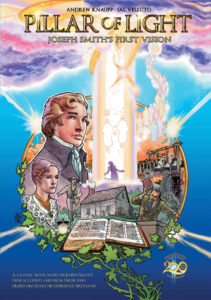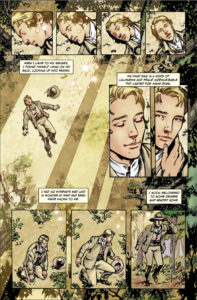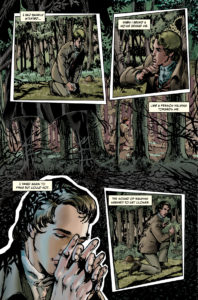 A guest post by Andrew Knaupp, the co-creator, with Sal Velluto, of the graphic novel Pillar of Light: Joseph Smith’s First Vision.
A guest post by Andrew Knaupp, the co-creator, with Sal Velluto, of the graphic novel Pillar of Light: Joseph Smith’s First Vision.
When I set out to create a graphic novel of the First Vision I had some specific things in mind. I knew I wanted to show how the details of the four primary accounts all fit together into one story, but I also wanted to show the huge spiritual battle that happened to the young Joseph Smith. I also wanted to walk the fine line between creative expression and being respectful to a story that is extremely significant to millions of people. Could it be done, or was it a bar too high to meet?
I knew I needed an artist who could do more than just draw well. I needed someone who could translate spiritual concepts into visual representations. Creating a spiritual feeling in art is not an easy task. I had seen Sal Velluto‘s work on the Life of the Prophet Joseph Smith published in the Friend Magazine and knew he could do it. I was over-the-top excited when he agreed in February of 2019 to do the project with me. I knew how high the bar was, so I had decided that I wouldn’t rush the process. Sal would work on it in-between other projects, so he would have plenty of time to marinate on the ideas and concepts and to do the rendering at his highest level. I didn’t know if it would take us 2 years or 10 years, but I didn’t want to do it at all unless we did it right.
I gave him the script, as well as my copy of Joseph Smith’s deathmask, and a research binder I had created on historic American clothing of the 1820s. It was going to a daunting task to portray such an important person, Joseph Smith, not to mention portraying God the Father and his Son Jesus Christ. I knew we wouldn’t be able to please everyone, but even the greatest art never does, but I believed we could please a majority. I felt that as long as we kept to the specifics in the accounts and didn’t take doctrinal leaps it could succeed in telling the story while still being dynamic, creative, and inspiring to read.
 The process worked well. Sal had the final say on all artistic decisions while I had the final say on all doctrinal decisions. As each page would begin to take shape in it’s rough form, we would discuss via email, or video chat, the pros and cons of each panel in portraying what the words of the accounts said. In the opening scene, we start at the end of the vision when he regains consciousness and is physically exhausted. We went through different drafts trying to determine how to show his exhaustion. Would he be too shaky to stand? Is he covered in sweat? Does he need to pick up a walking stick to support himself? Sometimes ideas didn’t translate onto paper the way we thought they would and we would have to keep changing the panels.
The process worked well. Sal had the final say on all artistic decisions while I had the final say on all doctrinal decisions. As each page would begin to take shape in it’s rough form, we would discuss via email, or video chat, the pros and cons of each panel in portraying what the words of the accounts said. In the opening scene, we start at the end of the vision when he regains consciousness and is physically exhausted. We went through different drafts trying to determine how to show his exhaustion. Would he be too shaky to stand? Is he covered in sweat? Does he need to pick up a walking stick to support himself? Sometimes ideas didn’t translate onto paper the way we thought they would and we would have to keep changing the panels.
The battle with Satan was especially difficult. It’s kind of an unspoken rule in the Church that we don’t talk much about him. The idea is implied that we are giving him too much credit or attention if we portray him or discuss him. Yet his attack on the young prophet was no small thing. Joseph’s descriptions used words like “destroyed” and “doomed.” This was no small passing moment but one of “great alarm.” The encounter also served as the opposite to the vision of diety. You can only tell how white something is if you have something black next to it. So we discussed at length and tried many options for how he would be portrayed. Should he just be darkness? Should he look like a liquid or a gas? Is he alone or did he bring demonic assistants? With each artistic decision, I would return to the written accounts to look at every single word.
 I started noticing when Joseph repeated a phrase or word and realized he was putting more emphasis on it by repeating it. For instance, in the 1835 account Joseph specifically mentions the sound of walking, twice. Joseph’s life in the forest and woods make him an expert at identifying sounds. He wanted us to know it was the specific sound of walking. He spins around because he expected to see someone who could produce that specific sound. Yet sees no one. How should we portray this? We decided that we needed to show Satan’s spirit body, and his feet. Even though as a spirit he wouldn’t be interacting with the ground the same way a physical body would, he was making the sound somehow. We also wanted to show that he was a single being, and not a group, since Joseph never implies or makes any statements about feeling the presence of multiple beings but specifically uses a singular reference when referring to Satan. We also knew we were going to show Satan with tentacles of evil and in our first few drafts of the initial attacks it came across like multiple things were attacking Joseph, or even that the forest itself was attacking him. By showing a single figure, we felt it better communicated the singular nature of Satan. It also had implications about the difference between Satan and God. Satan is forever alone, he will never have a family or true friends. Whereas God is always part of a family, with His Son and His Angels he is not alone, but part of a unified group.
I started noticing when Joseph repeated a phrase or word and realized he was putting more emphasis on it by repeating it. For instance, in the 1835 account Joseph specifically mentions the sound of walking, twice. Joseph’s life in the forest and woods make him an expert at identifying sounds. He wanted us to know it was the specific sound of walking. He spins around because he expected to see someone who could produce that specific sound. Yet sees no one. How should we portray this? We decided that we needed to show Satan’s spirit body, and his feet. Even though as a spirit he wouldn’t be interacting with the ground the same way a physical body would, he was making the sound somehow. We also wanted to show that he was a single being, and not a group, since Joseph never implies or makes any statements about feeling the presence of multiple beings but specifically uses a singular reference when referring to Satan. We also knew we were going to show Satan with tentacles of evil and in our first few drafts of the initial attacks it came across like multiple things were attacking Joseph, or even that the forest itself was attacking him. By showing a single figure, we felt it better communicated the singular nature of Satan. It also had implications about the difference between Satan and God. Satan is forever alone, he will never have a family or true friends. Whereas God is always part of a family, with His Son and His Angels he is not alone, but part of a unified group.
Sal’s artistic ideas were so great to see and he brought many symbols and compositional elements into the visuals that had not occurred to me. It was a synergistic relationship that was a wonderful experience. The timeline was able to be accelerated due to some openings in Sal’s schedule, combined with a desire to finish the project for the 200th anniversary (which neither of us had specifically realized was happening until several months after we had started). We were able to finish the art and post it online by the evening of March 26, 2020, which we think is a strong candidate for the actual date of the First Vision. I was very satisfied with the final product and hope it stands the test of time for accuracy, attention to detail, doctrinal consistency, and visual appeal.
We’ve made the entire book available for Free online at www.latterdaysaintcomics.com as our gift to the youth of the church for the 200th anniversary.

.
Oh! I didn’t realize it was out! Thank you for that info and for the writeup. Congratulations on finishing!
Dittos 2 the above poster. “Congratulations on finishing!” I’m saving 4 a copy to give 2 my In-Law, & my Grandchildren.